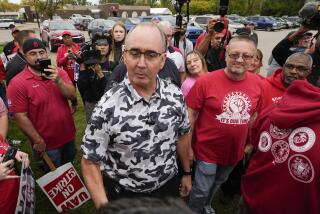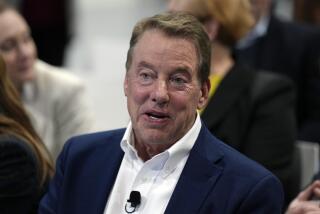Ford Posts Record Turnaround : Autos: Pickups and sport utility vehicles pull the company out of the loss lane to a $3-billion improvement over 1992.
- Share via
DEARBORN, Mich. — Ford Motor Co. marked the biggest year-to-year turnaround in its history Wednesday, reporting strong fourth-quarter and 1993 earnings that contrast with hefty losses a year earlier and underline the rebound of the Big Three.
The nation’s second-largest auto maker said brisk truck sales, lower marketing costs and an improving general economy contributed to net income of $719 million in the fourth quarter. Earnings for all of 1993 were $2.53 billion.
Last year’s profit represents a $3-billion improvement from 1992, when Ford had a loss of $502 million before taking a huge onetime accounting charge for future retirees’ medical benefits. Ford lost $840 million in the fourth quarter of 1992.
“These are the best results we’ve had in some time,” said David McCammon, Ford’s vice president and treasurer. “It was a record improvement, even though sales were up only 3%.”
Sales in the United States, however, were much stronger. Ford’s U.S. car and truck sales jumped 13.8%, while sales abroad dipped 11%, largely because of the economic slump in Europe.
Ford sold nearly 6 million vehicles worldwide. Revenue for the year was $108.5 billion, up 8% from 1992. Fourth-quarter sales were $27.8 billion, up 9.6%.
The company earned $1.30 a share in the fourth quarter, contrasted with a loss of $1.85 a share a year earlier. For all of 1993, Ford earned $4.55 a share, after losing $15.61 a share in 1992 (with the accounting charge).
Although the profit was slightly higher than Wall Street had expected, Ford’s stock fell $1 on Wednesday in trading on the New York Stock Exchange, to $68.50 a share.
Financially, Ford is the strongest of the Big Three. It will announce today that about 150,000 of its employees, both white-collar and blue-collar, will receive profit-sharing checks for the first time in four years.
But Ford is not alone in reaping the rewards of the U.S. auto industry’s resurgence. Chrysler earned $777 million in the fourth quarter, and General Motors was expected to report today that its troubled North American operations were profitable in the three-month period.
Ford’s profit reflects an increased share of the U.S. vehicle market--25.5% last year, up from 24.7% in 1992. Much of that gain was due to truck sales, which now account for nearly half of all Ford’s sales.
The models most in demand were the F-series pickups--now the top-selling vehicles in America--the Explorer sport utility vehicle and the Mercury Villager minivan.
“These vehicles are very profitable and are built at factories operating at full capacity,” said David Cole, executive director of the University of Michigan’s Office for the Study of Automotive Transportation.
With demand so high, Ford is operating many of its plants on overtime and looking for ways to speed up production, although no plans for new plants have been announced.
The company said rebates averaged $865 in the fourth quarter, down from $1,150 a year before.
“Looking ahead, we’re in good shape for 1994,” said Alex Trotman, chairman and chief executive. “We have strong new products, and we expect better economic conditions.”
Still, some problems remain.
Ford’s Jaguar subsidiary lost $371 million in 1993, compared to a $412-million loss in 1992. The company lost $407 million in Europe, despite the successful introduction of its Mondeo family sedan.
Ford’s San Francisco-based First Nationwide Bank savings and loan, which has been for sale, lost $55 million in 1993, compared to a loss of $72 million in 1992.
But its financial services arm earned $1.6 billion, up $557 million from a year ago.
Profit Is Job One
The manufacturer of the best-selling car and truck in America, Ford Motor Co. has emerged as the strongest of the Big Three auto makers financially, as well.
In billions of dollars:
March, 1988: $1,623 June: 1,663 Sept.: 856 Dec.: 1,158 March, 1989: 1,637 June: 1,407 Sept.: 477 Dec.: 314 March, 1990: 506 June: 771 Sept.: 102 Dec.: -519 March, 1991: -884 June: -324 Sept.: -574 Dec.: -476 March, 1992: -6,660* June: 387 Sept.: -272 Dec.: -840 March, 1993: 572 June: 775 Sept.: 463 Dec.: 719
* Includes provision for future health care costs for retirees
Sources: Company reports; American Automobile Manufacturers Assn.; Bloomberg Business News
Researched by ADAM S. BAUMAN / Los Angeles Times






